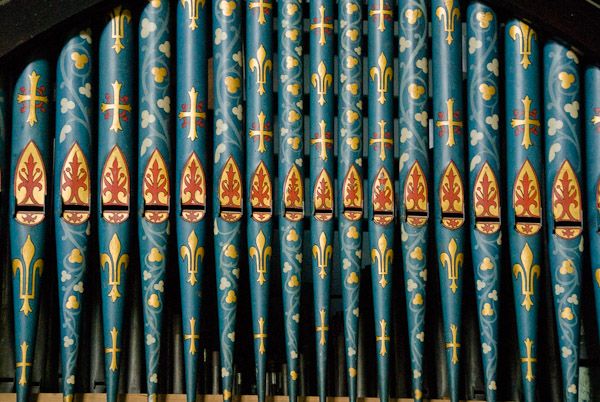Illustrated Dictionary of British Churches - Organ Definition
History and Architecture
- Aisle
- Altar
- Ambulatory
- Angel Roof
- Apophyge
- Apse
- Arcade
- Arch
- Archivolt
- Base
- Battlement
- Bay
- Belfry
- Bell Tower
- Bellcote
- Bench End
- Board Bell Turret
- Body
- Boss
- Box pew
- Bracket
- Broach Spire
- Buttress
- Canopy
- Capital
- Cartouche
- Chancel
- Chancel Arch
- Chancel Screen
- Chantry
- Chapel
- Chapter House
- Choir
- Clerestory
- Cloister
- Communion Rail
- Compound Column
- Consecration Cross
- Corbel Head
- Crossing
- Crypt
- Early English
- Easter Sepulchre
- Effigy
- Fan Vaulting
- Font
- Font cover
- Funerary Helm
- Gallery
- Gargoyle
- Gothic
- Green Man
- Grotesque
- Hatchment
- Herringbone
- Hogback Tomb
- Holy Water Stoup
- Hunky Punk
- Jesse Window
- Kempe Window
- Lady Chapel
- Lancet
- Lectern
- Lierne
- Lych Gate
- Misericord
- Monumental Brass
- Mullion
- Nave
- Ogee
- Organ
- Parclose Screen
- Parish Chest
- Pendant
- Perpendicular Gothic
- Pew
- Pinnacle
- Piscina
- Poor Box
- Poppy Head
- Porch
- Priest's Door
- Pulpit
- Purbeck Marble
- Quire
- Rebus
- Reliquary
- Reredos
- Retable
- Romanesque
- Rood
- Rood Loft
- Rood screen
- Rood Stair
- Rose Window
- Round Tower
- Sanctuary
- Sanctuary Knocker
- Saxon Period
- Scratch Dial
- Sedilia
- Spire
- Statue Niche
- Stoup
- Tomb Recess
- Tracery
- Transept
- Triforium
- Tympanum
- Undercroft
- Vaulting
- Victorian Gothic
- Wall Monument
- Wall Painting
- Wheel Window
Organ
Organs were used in church services from as early as the 10th century to provide accompaniment for hymns. Thse early organs were much smaller than those we are used to seeing today. By the 15th century even the smallest, poorest church might possess an organ. These might be placed in the rood loft, or on the floor of the church. These early organs had to be manually 'blown', a tedious job reserved for choirboys, who had to pump a wooden handle located in a small cupboard behind the organ. Bored choirboys left their initials carved into the wood near the blower handle. Organs were outlawed during the Commonwealth, and many were destroyed.
They became popular once again in the 18th century and have remained a comon feature in parish churches ever since. Though modern organs are small, electrified, and not terribly interesting from a historical viewpoint, many churches maintain large organs dating to at least the Victorian period or even earlier. The most obvious feature of these organs are the highly decorated pipes, which are often painted in bright colours.

Martock, Somerset


